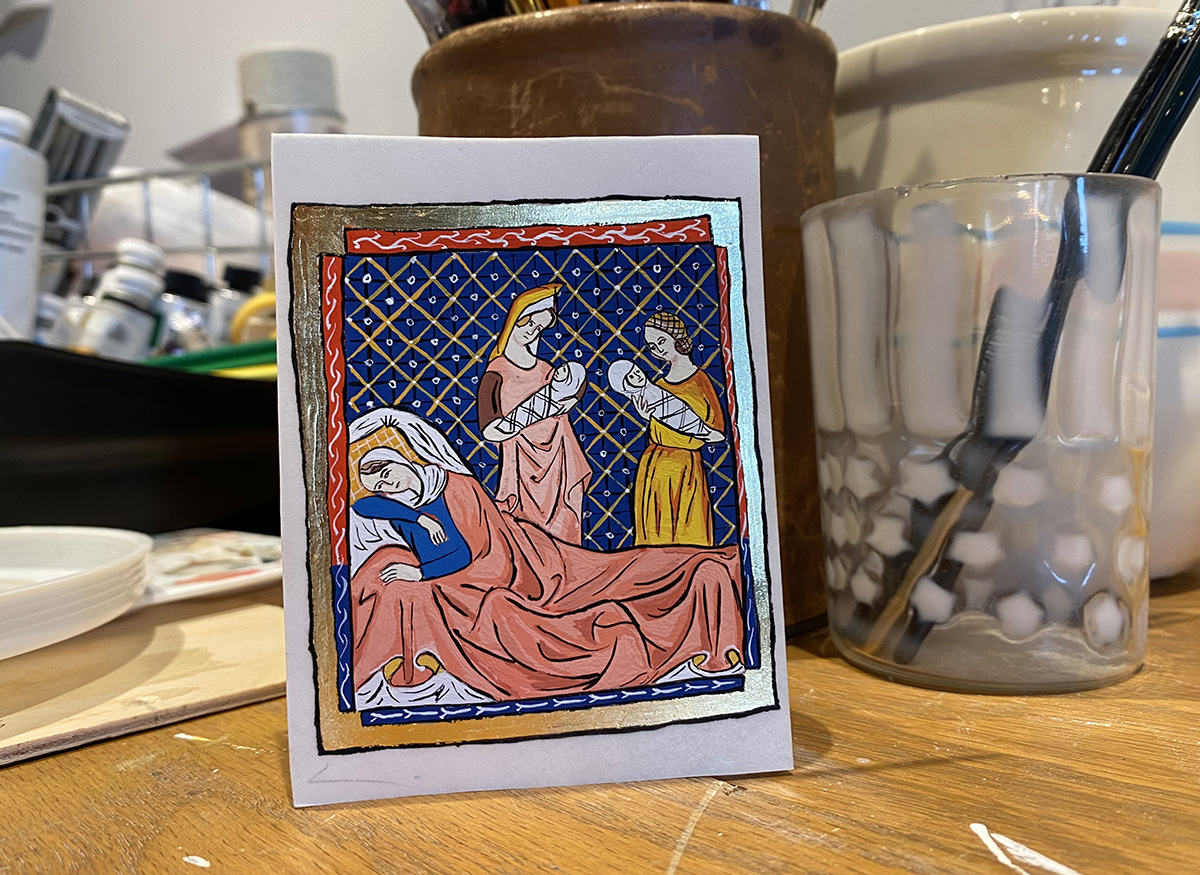
From the 17th to the 21st of July, 2023, I attended a course entitled Medieval Painting and Manuscript Illumination at the City & Guilds of London Art School in the UK. Here, from 10.00-17.00 every day, our professor introduced us to the basics of preparing vellum, gilding with gold leaf, burnishing with agate, and painting at miniature scales.
When I told people that I would be doing this course, often the response was laughter. ‘Of course you are’ they said. I used to want to be a monk when I was a child, probably because I grew up in the shadow of Canterbury Cathedral, first established by Augustine in 597, rebuilt and expanded in 1070. Most of our school trips until I moved away when I was 14 involved visiting the cathedral: re-enacting the murder of Thomas Beckett; making crayon rubbings of the engraved paving stones; categorising the arches in to Norman, Gothic, Romanesque, Neo-Gothic; going down in to the crypt, the oldest surviving part, and finding the mistakes in the carved capitals of the columns holding up the ceiling.
These mistakes meant a lot to me, where the stone masons had begun and sheepishly left unfinished the beginnings of a flowering vine in the wrong place. Everywhere in the cathedral were indicators of unimaginable effort by anonymous people. Uncountable of hours of skill and attention – most too high up in the vaulted ceiling to be seen. Thousands of people doing very complicated things, very slowly, and very long ago. Naturally, I fell in love with it.
Hence, the manuscripts, and my recent descent in to medievalism (which in many ways feels like a return to childhood). When I go home to Oxford between semesters, I spend my time in the Bodleian library, where medieval manuscripts collect like miniature cathedrals – each one a testament of their own making, above and beyond the linguistic contents themselves. Each is ridiculous and exorbitant, overstuffed with signifiers and allusions that lead you in circles. You tour these books, you cannot read them. Every manuscript bears traces of erased lines, unclosed arcs, patterns that got away from their maker and eclipse the text.
When people laugh, they aren’t necessarily wrong. Marginalia are often very funny in their strangeness, brevity, lewdness, wild anatomical inaccuracies, and incongruency with the text they purport to illustrate. ‘Not something you see every day’ my dad texts back when I send him a picture of my most recent marginal copy from the 2nd day of my course. The image is of a blue woman emerging from a yonic portal of blue and red cloth, in to which two orange horses dive head first, on each of whose back is a tiny baby.
Nevertheless, I spent 5 days devoutly bent over my small sheets of vellum; first, holding my breath so as not to disrupt the loose gold leaf hanging from my knife, then breathing on to my miniatum to ‘wake it up’ and make it sticky again. I learned to move my brush between my heartbeats, to get the thinnest and most stable line. I learned to stroke the vellum as if it were still attached to the calf in came from, searching for the ‘pore side’. I asked my mother if she had kept any of our dog’s teeth, as I learn these are ideal for burnishing with.
I spent my last 2 days with one image that I’d brought from my own research, 2 inches across and 3 inches down, showing Rebecca in the aftermath of giving birth to Jacob and Esau from somewhere between 1300-1325AD (relatively recent, as far as these things go). There is no sign of struggle in the image, only the relentless facial passivity symptomatic of this aesthetic period. The mother and her two midwives are rendered plainly, each taking far less time for me to recreate than the background or the border. When I take the tube home after the course I find myself writing about them, about how they can hold such affect in a time before autobiography, interiority, individuality or even really subjectivity had entered in to Western European literature or art.
I became obsessed with this tiny room, which seemed a mix between obscene and euphemistic – the new mother buried under yards of bright fleshy fabric, turned away from her children – whose faces are circles surrounded by swaddling bandages. For me this image came to exemplify the medieval refusal of the interior, one so vehement that the refusal itself becomes an elephant in the miniature room. She was so covered, and so exposed, and I could cover her with my thumb. It sits on my desk now, at the start of a new semester, the vellum stiff enough to stand by itself.
–Max Watkins MFA ’25




